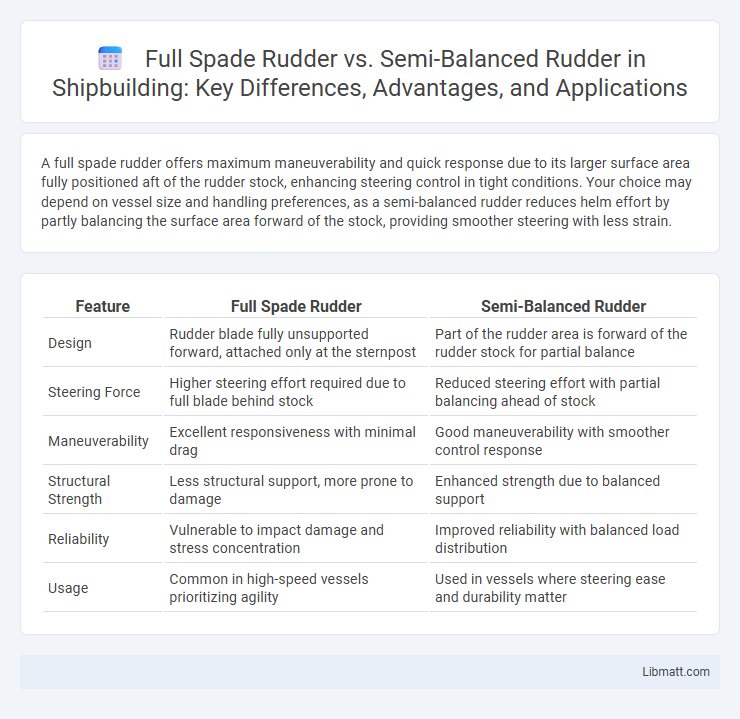A full spade rudder offers maximum maneuverability and quick response due to its larger surface area fully positioned aft of the rudder stock, enhancing steering control in tight conditions. Your choice may depend on vessel size and handling preferences, as a semi-balanced rudder reduces helm effort by partly balancing the surface area forward of the stock, providing smoother steering with less strain.
Table of Comparison
| Feature | Full Spade Rudder | Semi-Balanced Rudder |
|---|---|---|
| Design | Rudder blade fully unsupported forward, attached only at the sternpost | Part of the rudder area is forward of the rudder stock for partial balance |
| Steering Force | Higher steering effort required due to full blade behind stock | Reduced steering effort with partial balancing ahead of stock |
| Maneuverability | Excellent responsiveness with minimal drag | Good maneuverability with smoother control response |
| Structural Strength | Less structural support, more prone to damage | Enhanced strength due to balanced support |
| Reliability | Vulnerable to impact damage and stress concentration | Improved reliability with balanced load distribution |
| Usage | Common in high-speed vessels prioritizing agility | Used in vessels where steering ease and durability matter |
Introduction to Rudder Types
Full spade rudders are completely detached from the keel, offering superior maneuverability and responsive steering, which benefits performance sailing and tight navigations. Semi-balanced rudders, partially supported by the keel or skeg, provide enhanced directional stability and reduced steering effort, ideal for cruising vessels prioritizing control and durability. Understanding your boat's design and sailing conditions helps determine the optimal rudder type for your needs.
Defining Full Spade Rudders
Full spade rudders are single-piece rudders fully unsupported along the leading edge, providing maximum maneuverability and responsiveness by minimizing hydrodynamic drag. Unlike semi-balanced rudders, which have a portion of the rudder surface ahead of the stock to reduce steering effort, full spade rudders rely entirely on their design for balanced performance. This type of rudder is commonly used in high-performance sailboats due to its precise control and efficient handling characteristics.
Understanding Semi-Balanced Rudders
Semi-balanced rudders feature a portion of their surface area positioned forward of the rudder stock, reducing the helm effort required to steer compared to full spade rudders, which are entirely aft of the stock. This design improves maneuverability and decreases steering torque, enhancing your control in various sea conditions without compromising structural strength. Understanding semi-balanced rudders helps optimize performance and responsiveness in sailing vessels by balancing hydrodynamic forces more efficiently.
Key Design Differences
Full spade rudders are fully unsupported by a keel or skeg, hinged only at the top, providing maximum maneuverability and reduced drag due to their exposed design. Semi-balanced rudders feature a portion of the rudder blade ahead of the pivot point, easing steering loads and offering greater structural support from partial skeg attachment. Your choice depends on the balance between responsiveness and durability, with full spade rudders excelling in agility and semi-balanced rudders offering enhanced stability and strength.
Hydrodynamic Performance Comparison
Full spade rudders offer superior hydrodynamic performance due to their streamlined shape and reduced wetted surface area, resulting in lower drag and more responsive steering. Semi-balanced rudders, featuring partial support with a leading edge balanced ahead of the rudder post, provide improved control forces and reduced helm effort but generate slightly higher drag compared to full spade designs. Computational fluid dynamics (CFD) studies indicate that full spade rudders achieve better lift-to-drag ratios, enhancing maneuverability especially at higher speeds.
Maneuverability and Handling
Full spade rudders offer superior maneuverability due to their larger surface area and complete detachment from the keel, providing faster and more responsive steering especially at low speeds. Semi-balanced rudders have part of their area forward of the rudder stock, reducing steering effort and improving handling stability over longer distances but with slightly less precise control. Your choice depends on whether you prioritize sharp, agile turns or steadier, less forceful steering input.
Structural Strength and Durability
Full spade rudders offer superior structural strength due to their solid, one-piece construction that evenly distributes loads across the rudder stock and blade, resulting in enhanced durability under heavy stress. Semi-balanced rudders incorporate a portion of the blade area ahead of the rudder stock, which reduces steering effort but introduces stress concentration points that may require reinforced materials to maintain long-term durability. The choice between full spade and semi-balanced rudders depends on balancing the need for structural robustness with ease of handling, making full spade rudders preferable in high-performance or heavy-duty marine applications.
Maintenance and Repair Considerations
Full spade rudders generally require more frequent maintenance due to their unsupported, cantilevered design, which places higher stress on the rudder stock and bearings, increasing wear and potential for damage. Semi-balanced rudders benefit from partial support and lower loads on the rudder stock, often resulting in easier inspection, reduced bearing wear, and simpler repair processes. Marine surveyors recommend regular lubrication and thorough inspection of bearing areas for full spade rudders to mitigate costly repairs and ensure structural integrity.
Suitability for Different Vessel Types
Full spade rudders offer superior maneuverability and are ideal for high-performance vessels like racing yachts and fast motorboats, where quick steering response is crucial. Semi-balanced rudders suit larger ships and commercial vessels, providing better stability and reduced helm effort in heavy seas. Your choice depends on the vessel's size, speed, and operational environment to ensure optimal handling and control.
Summary: Choosing the Optimal Rudder
Full spade rudders offer superior maneuverability and responsiveness due to their entire blade being unsupported by a skeg, ideal for performance sailing. Semi-balanced rudders, with part of the blade forward of the stock, reduce steering effort and provide better protection, making them suitable for cruising and rough conditions. Your choice depends on prioritizing agility versus durability and ease of handling in your sailing environment.
Full spade rudder vs semi-balanced rudder Infographic

 libmatt.com
libmatt.com